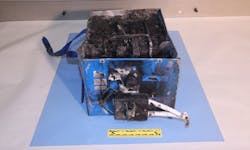NTSB identifies origin of Boeing 787 battery fire, scrutinizes design, certification, and manufacturing
WASHINGTON, 8 Feb. 2013. The National Transportation Safety Board (NTSB) has identified the origin of the 7 Jan. 2013 battery fire on a Japan Airlines 787 at Boston Logan Airport, and has focused the investigation on the battery system’s design and certificationrequirements.
"U.S. airlines carry about two million people through the skies safely every day, which has been achieved in large part through design redundancy and layers of defense," recognizes NTSB Chairman Deborah A.P. Hersman. "Our task now is to see if enough, and appropriate, layers of defense and adequate checks were built into the design, certification, and manufacturing of this battery.
NTSB investigators determined that a majority of evidence from the flight data recorder and thermal and mechanical damage pointed to an initiating event in a single cell of the Japan Airlines (JAL) lithium-ion battery, which includes eight individual cells.
One cell showed multiple signs of short circuiting, leading to a thermal runaway condition, which then cascaded to other cells, reveals an NTSB spokesperson. Charred battery components indicated the temperature inside the battery case exceeded 500 degrees Fahrenheit.
Investigators, working to find the cause of the initiating short circuit, ruled out mechanical impact damage to the battery and external short circuiting. Signs of deformation and electrical arcing on the battery case occurred as a result of the battery malfunction and were not related to its cause, says a representative.
Potential causes of the initiating short circuit currently being evaluated include: battery charging, the design and construction of the battery, and the possibility of defects introduced during the manufacturing process, says Chairman Hersman.

